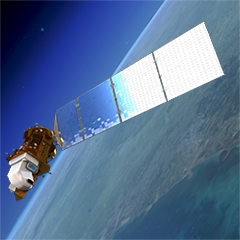
There is, however, a bit of tweaking going on as Landsat calibration and instrument teams work to correct a few small issues. Landsat 8’s Operational Land Imager (OLI), for example, is composed of tens of thousands of very sensitive detectors-so sensitive that tiny discrepancies are evident in Landsat 8 images of dark, uniform areas such as large expanses of water. The calibration team has made an overall improvement to the radiometry (color fidelity) of the OLI sensor’s bands to resolve this problem.
The satellite’s Thermal Infrared Sensor (TIRS) acquires two infrared bands. Both are being affected, to different degrees, by a stray light problem. “Light from outside the area we are looking at is getting into the telescope-it’s being reflected from something in the sensor itself-which is causing ‘ghosting’ in the images,” said Ron Morfitt, Landsat 8 Calibration and Validation Lead. “To fix the problem, the calibration and instrument teams are scanning the moon, which is a very bright object with a very dark background, to try to find out exactly where the stray light is coming from. We’ll then build a filter to remove the ghosts from the images,” Morfitt added. “It is a very novel solution.”
Landsat 8 and Landsat 7 are also being managed in a novel way, with the newer satellite being used to extend the capabilities-and lifespan-of the older one. “Landsat 7 recently went to a continental landmass acquisition strategy,” said Lacasse. “Capturing images of islands, for example, was very inefficient due to Landsat 7 scheduling constraints. The responsibility for capturing images of islands has been turned over to Landsat 8, with its much more sensitive sensor. The change helps to conserve the resources of Landsat 7 while still meeting our science goals.”
This change has also resulted in more data than anticipated being acquired by both satellites. Freed from routine acquisition of island images-as well as those of water, Antarctica, and night scenes-Landsat 7’s output has increased from 375 to 438 scenes per day while at the same time prolonging the life of the ETM+. Landsat 8 is also collecting more than its anticipated 400 scenes per day. “We are currently scheduling 550 images per day,” said Gene Fosnight, Landsat Acquisitions Director. “Landsat 8’s new bands and increased sensitivity make it particularly useful for dark objects like water and bright objects like snow and ice. We are acquiring those types of images at a higher rate than ever before. Landsat 8 is also cautiously beginning night imaging campaigns of active volcanoes.”
More data. Better data. It’s definitely something to celebrate.

Be Part of What’s Next: Emerging Applications of Landsat at AGU24
Anyone making innovative use of Landsat data to meet societal needs today and during coming decades is encouraged to submit and abstract for the upcoming “Emerging Science Applications of Landsat” session at AGU24.





